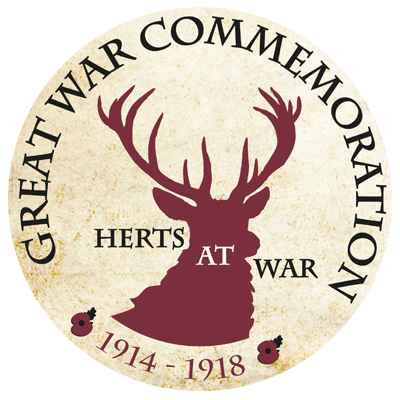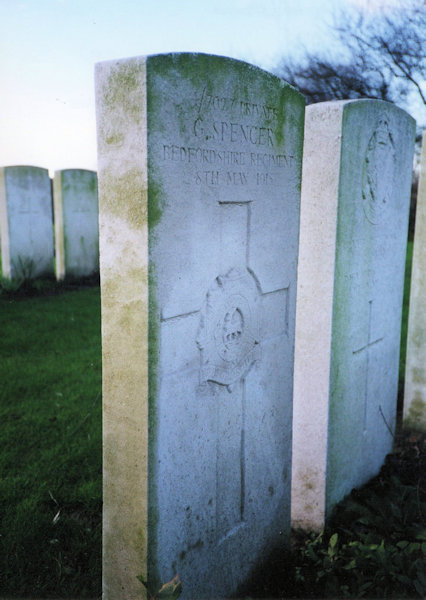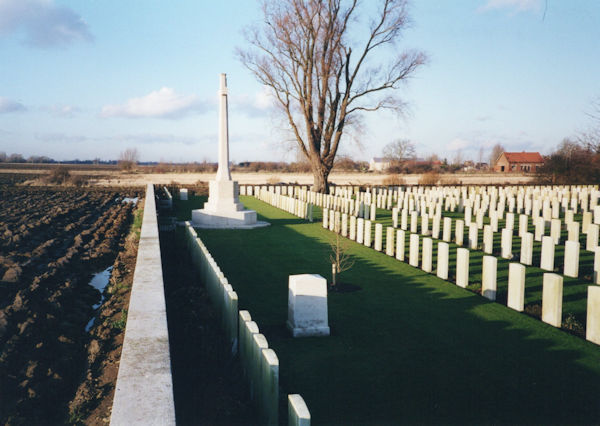Name
George Arthur Spencer
1883
Conflict
First World War
Date of Death / Age
18/05/1915
Rank, Service Number & Service Details
Private
4/7027
Bedfordshire Regiment
2nd Bn.
Awards: Service Medals/Honour Awards
1914 (Mons) Star, British War and Victory Medals
Cemetery/Memorial: Name/Reference/Country
PONT-DU-HEM MILITARY CEMETERY, LA GORGUE
V. B. 23.
France
Headstone Inscription
Not Researched
UK & Other Memorials
Hitchin Town Memorial, St Mary's Church Roll of Honour (Book), Hitchin
Pre War
Wartime Service
George Arthur’s service history has not been found, but it is likely he was a serving soldier or a Territorial before war was declared as he landed in France on 11 November 1914 – this would have been too early for a new soldier.
George received the Regimental Number 4/7027 and it is recorded that he volunteered in August 1914 – this might support the view that he was a territorial, because they were only required to serve on ‘Home’ service but could volunteer to serve abroad.
He has an entry in the National Roll of the Great War – these were normally placed by family members using what they knew and are not always 100% correct. For instance it suggest s that he was involved in Retreat from Mons August 1914, fought in the Battles of Loos (Sept/Oct 1915) clearly these cannot all be correct and at Ypres. In fact the 2nd Bedfords were in South Africa in August 1914 and did not come back to the UK until 19th September. However, they did fight in the First Battle of Ypres in October/November 1914 and Battle of Festubert in May - when George was killed, and later, after George’s death, in the Second Action at Givenchy (June 1915) and the Battle of Loos in September 1915. So it is easy to see how confusion arose.
The Battalion had moved into trenches known as the ‘Indian Village’ sector at the Battle of Festubert and an attack began at dawn on the German trenches. The assault had to begin from a communications trench which meant crossing 50 yards of completely open country resulting in many men being killed or wounded. High explosive, shrapnel and machine-gun fire were responsible for most of the casualties.
The Battalion War Diary for the 18 May 1915 records: “About 3 a.m. telephonic instructions were received from the Brigadier, that the Battn. should advance along the communication trench towards K.4 & K.5, and take the German trench from that flank, to join up with the Cameron Highlanders, who were said to be still in possession of a portion of the trench. A supply of Bombs having been received, the bomb throwers with 'D' Coy. under 2nd Lt. C.H. Brewer; with 'A' and 'C' coys. in that order, in support, under Capt. W. Hutton-Williams, & Bt. Lt. Col. E.I. de S. Thorpe respectively, were ordered to make their way along the communication trench to K.5, to gain possession of that point & work along German trench towards L/8. to meet the Cameron Highlanders. 'B' Coy. under 2/Lt. F. Powell was kept in reserve. While this attack was developing, the C.O. received authentic information, that the party of Cameron Highs: who has gained the enemy trench, had been bombed out and retired thence during the night. This information, and also the fact that, the Bn. was very weak numerically, was telephoned by the C.O. to the Brigadier, who replied that if the C.O. who absolutely convinced that the Cameron Highs: were no longer holding any of the German trench, he should stop the further advance of the Battn. and make good the ground occupied. The Bn. therefore consolidating K.4 & the communication trench, holding it with the bombthrowers & 'D' 'A' & 'B' coys. 'C' coy. & B remaining behind L1-L2. During the advance towards K4, Capt. W. Hutton-Williams was killed and about 6 men killed or wounded crossing the gap in the trench which was swept by Machine Gun & rifle fire. The Battn. remained in this position all day, being heavily shelled by H.E. & shrapnel the whole time. This party was under Capt. C.C. FOSS, D.S.O. who had partially reconnoitred the route. Night of 17-18 May 1915 During the night 17th-18th May, 2nd Lt. B.H. Waddy 3rd Gloucester Regt. attached, who had been doing excellent scouting and reconnaissance work, had to be removed from the firing line by order of the M.O. & was admitted to Hospital. During this night too, the Battn. had the misfortune to lose the services of Lieut. D.G. WATSON, R.A.M.C. the M.O. who had been most assiduous in tending & removing wounded from the firing line in a conspicuously gallant manner, under heavy shell fire, being severely wounded by shrapnel on his way back to his dressing station. 7 stretcher bearers were also either killed or wounded.”
He was buried in Plot 5, Row B, Grave 23 in Pont-du-Hem Military Cemetery, La Gorgue Nord in France. His headstone states that he was killed on the 8th May.
Additional Information
Acknowledgments
Adrian Dunne, David C Baines, Jonty Wild



